
Town & Country
News
December 2006

The Past, Present & Future
It has often been said that Brass Bands were born in the churches. They provided the necessary music and accompanied the hymn singing. Provision of an elevated rostrum in the lower tower area must have been quite impressive, and there is still evidence of them in many local churches.
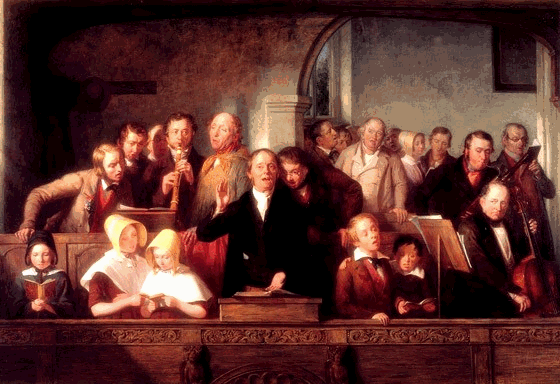
Detail from "A Village Choir", 1847, Thomas Webster
(V & A Museum)
Brass bands first appeared around the country in the mid nineteenth century – the bandsmen invariably came from ‘working class’ families and were seldom joined by those of higher social status, although a measure of financial support was sometimes given by industrial firms, probably for commercial publicity.
It was over 130 years ago that a carrier’s cart rumbled through the gates of a 17th century Jacobean manor house - Stalham Hall - with a special consignment from London. The order had been placed with Distin (Boosey & Co.) a few weeks earlier by Edward Cooke, the Hall’s owner, and comprised a set of instruments needed to form a brass band for Stalham.

Stalham Hall
Mr. Cooke was a landowner and philanthropic businessman who thought that the formation of the band would not only serve the community, but also give his workers something to do during the dark winter afternoons.
Instruments were not cheap. Even a basic cornet cost £3. 3s. 0d. His farm labourers were earning around 9s. (45p) a week and could not afford the outlay, so Mr. Cooke paid for the instrument set on the condition that the band paid the money back from engagement fees. The first rehearsal room was a large barn in the back garden of the Hall, and the Stalham Brass Band was born. The first conductor was Mr.Pigg of North Walsham.
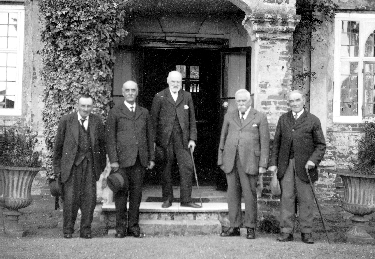
Some of the early members of the band at a reunion outside Stalham Hall in 1934
For this new genre there was however the problem of where to get music. Due to a lack of a really professional orchestral tradition, brass bands satisfied a thirst for good music and therefore transcriptions of popular classical music and operatic themes became the basic element of band repertoire. To begin with the only way that small village or town bands could obtain any music was when a travelling circus or fair came to visit. These had their own musical ensembles providing the music for performances. A director of music would constantly keep the repertoire updated to reflect the mood and events of the time. Selling copies to local bands therefore provided a welcome income. The other way was for band players to transcribe music by hand into manuscript books and some early examples of Stalham’s still survive.
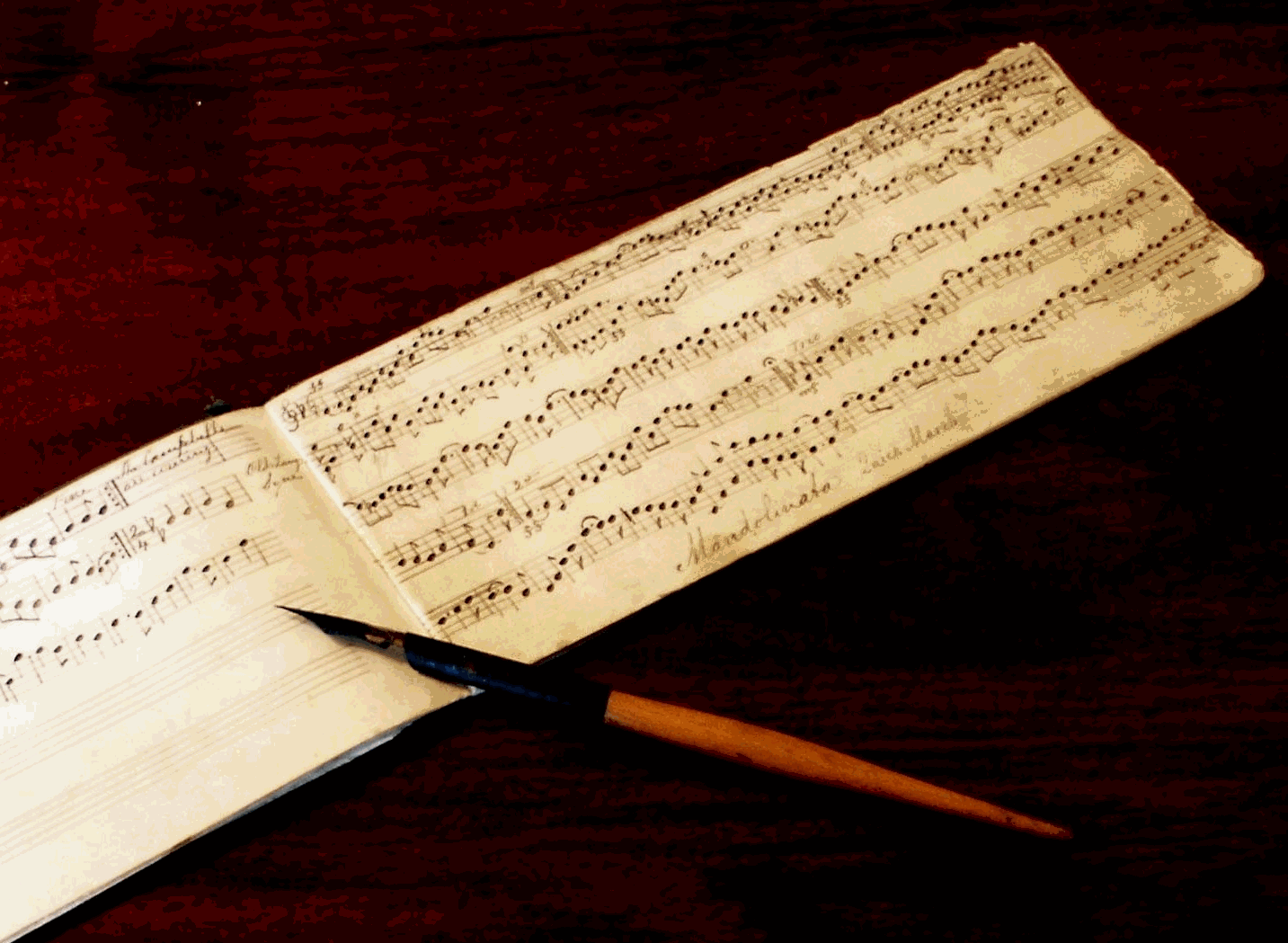
Manuscript book from Stalham Band c1870
Most towns and many villages were forming brass bands over the ensuing years. Equally, many did not survive for very long. Many bands consisted of entire families of players. At one time Stalham Brass Band had nine Spantons from two related families in its ranks. It is still the case, today, that players continue with the band that their parents and grandparents played in, and the band becomes an extended family group.
Stalham Band members Harry, Reggie and Sid Tillet, in 1937
Those communities that ‘possessed’ a brass band were very protective of it. Ranking above the football, cricket or darts teams, ‘the band’ was a community entity beyond reproach, a philosophy which still continues to this day.
There are no accurate records for how many brass bands existed at that time but it is thought to be about 15,000. Between the wars the numbers had dropped to about 6000, although this number was fairly stable. By the 1980’s the number had dropped further to around 2500. The present count is around 1700.
At one time all bands involved themselves in various contests, be it on a national or local scale. Stalham Brass Band was very successful, regularly taking the prizes.
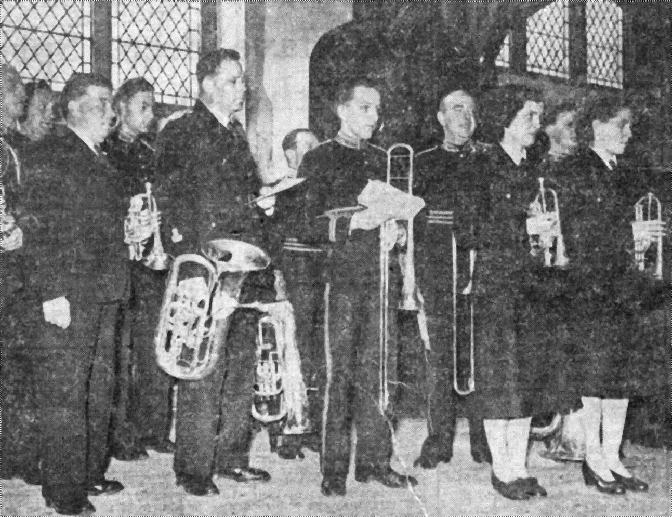
Cup Winners; Stalham wait to perform at the East Anglian Contest in Norwich.
Monday April 19th 1954.
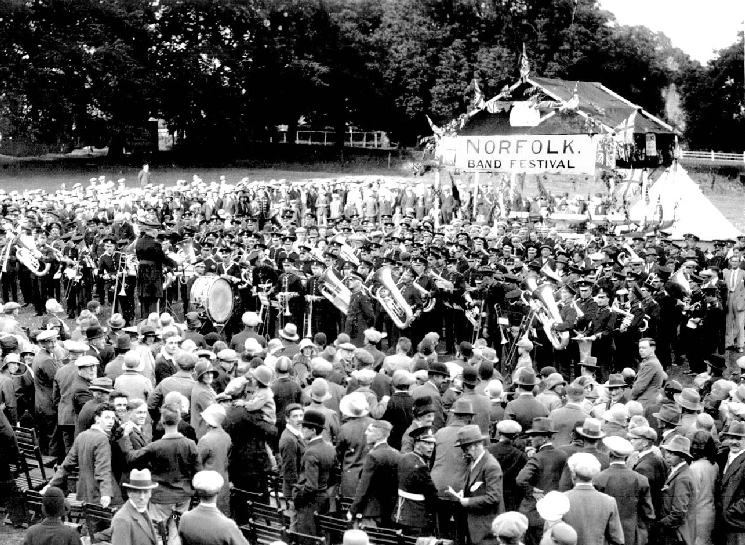
1930 Band Festival at Fakenham
In the mid 1970’s the band decided that contests were an indulgence which did not benefit the community. The contesting scene had also changed. Venues were further away, increasing out of proportion the cost of competing. Rule changes allowed bands to spring up overnight, take the best players from other bands and even field professional players. As successful as they were at competing, the lack of any heritage resulted in their eventual demise after a few years. In the meantime however they had damaged relations within the banding community and contest scene. Poaching players from other bands to form a new one has never worked in the long term. As Roger Webster - one of the country’s most famed cornet players - points out;
...the most important considerations are the band, its history, traditions and loyal supporters. These can never be replicated.
Today under a quarter of bands still compete, the rest concentrating on involvement within their community.

The band ‘girls’ in 1971
Una Leatherdale, Josie Abbs, Lynne Lovett, Beryl Banester, Deanne Hudson, Linda Tillett
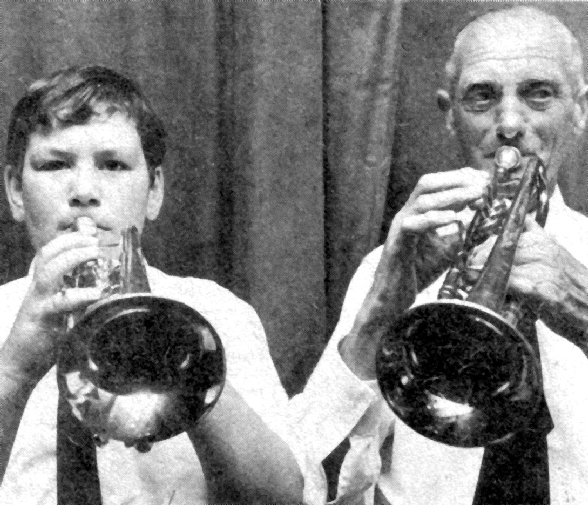
Youngest and older in 1971
Ten year old Christopher Sandell and 73-year-old Fred Ward
As with all community organisations, finance is a constant problem. Apart from the day to day running costs of insurance and venue hire, there can be a large capital burden. In the last ten years there have been less players taking up large instruments such as the bass. Apart from the size, it is more to do with the cost. A cornet whilst still costing well over £1000 is still far removed from the £5000 cost of a bass. Either can be too much for an individual to finance, or even to hire. Stalham Band’s philosophy is still to give its players the best opportunity, and it has worked hard over the past few years to ensure that it has a full compliment of instruments – over £40,000 worth – to welcome new players with.
The band is very grateful for the support it receives from local people, and also the businesses that form the Corporate Friends of Stalham Band. In the last few weeks, one of the members, Shell U.K. Ltd, donated a new Besson Sovereign Cornet to the band;
...in recognition of the band's unequalled community work in North Norfolk.
Back where it all began.
Tracey Tuttle, Business & External Affairs, Shell U.K. Ltd, presenting Tim Thirst with a Besson Sovereign Cornet at Stalham Hall.
A few days later another donation arrived, given anonymously this time from one of the individual Friends of Stalham Band, to enable the band to purchase a Besson Sovereign Eb Bass, one of the largest instruments in a band. The donor wished - they said - to emphasise, in a practical way;
...how much the community appreciates the band’s sterling work in music training initiatives for young people and its support for charities in the Stalham area.
In 2004 the band was awarded the Queen’s Golden Jubilee Award for
...encouraging people of all ages to gain traditional skills as brass musicians and providing entertainment at local activities and charity events.
Presentations were made to the band at County Hall by the Lord Lieutenant and a reception held by The Queen at St. James’ Palace, London. Stalham and only one other band in the British Isles are privileged to have received this award. The band members are proud to wear the insignia on their uniform.
Queen’s Golden Jubilee Award and Certificate
The British Brass Band movement has always been very active in the Commonwealth, and is still expanding in New Zealand, Australia and Canada, as well as the USA. Its popularity with audiences remains high everywhere.
Unfortunately in the U.K. music no longer receives the attention in the education system that it deserves. Thirty years ago there were very few school children under the age of seven who could not play the recorder. Today there are very few who can. Other countries recognise that schools where children actively take part in music-making achieve better grades, better discipline and less truancy. Those who play in a brass band, not only acquire a skill which can be used throughout their life, but they also mix with a cross section of age groups. Each year the band visits local schools to give presentations to the children about the history of the band in the community and to give them an opportunity to try out instruments.

A presentation to local school children during Brass Band Week
Playing in a brass band benefits young people as they move around the country – or the world – whilst training or with their employment. They will always receive a welcome into another brass band and will immediately feel part of their new community. Far more opportunities are available across the country for young people to make music with local brass bands than with orchestras or other groups.
The lack of involvement of young people, in activities which include adults, is a major reason for some of the social problems within the UK at the moment. In 2002 – the Queen’s Golden Jubilee Year – a new band - the Stalham Jubilee Brass Band - was established by Stalham’s director of music Tim Thirst, to concentrate on training young people. Wherever possible young people are trained by the band without charge and receive instruments on free loan while they are training. Members of both bands are trained in child protection and enhanced CRB checked.
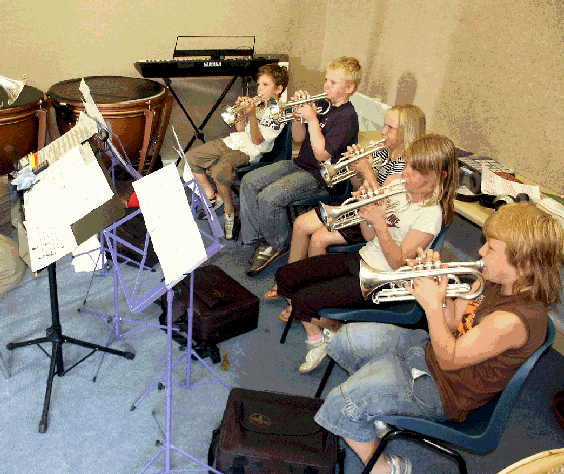
Small group training session for new young players
Lack of music training is also resulting in a shortage of qualified directors of music. Many bands do not even have a conductor in post any more. Throughout its history Stalham Brass Band has been fortunate to have held the services of professionally qualified band directors, as it still does today. Tim Thirst joined the band as a cornet player forty three years ago, has been a committee member for 38 years and its director of music for eight years. A postgraduate music instructor for young people and adults, he is also a musicologist of international renown specialising in brass bands.
Dr. Tim Thirst, Stalham Band’s director of music.
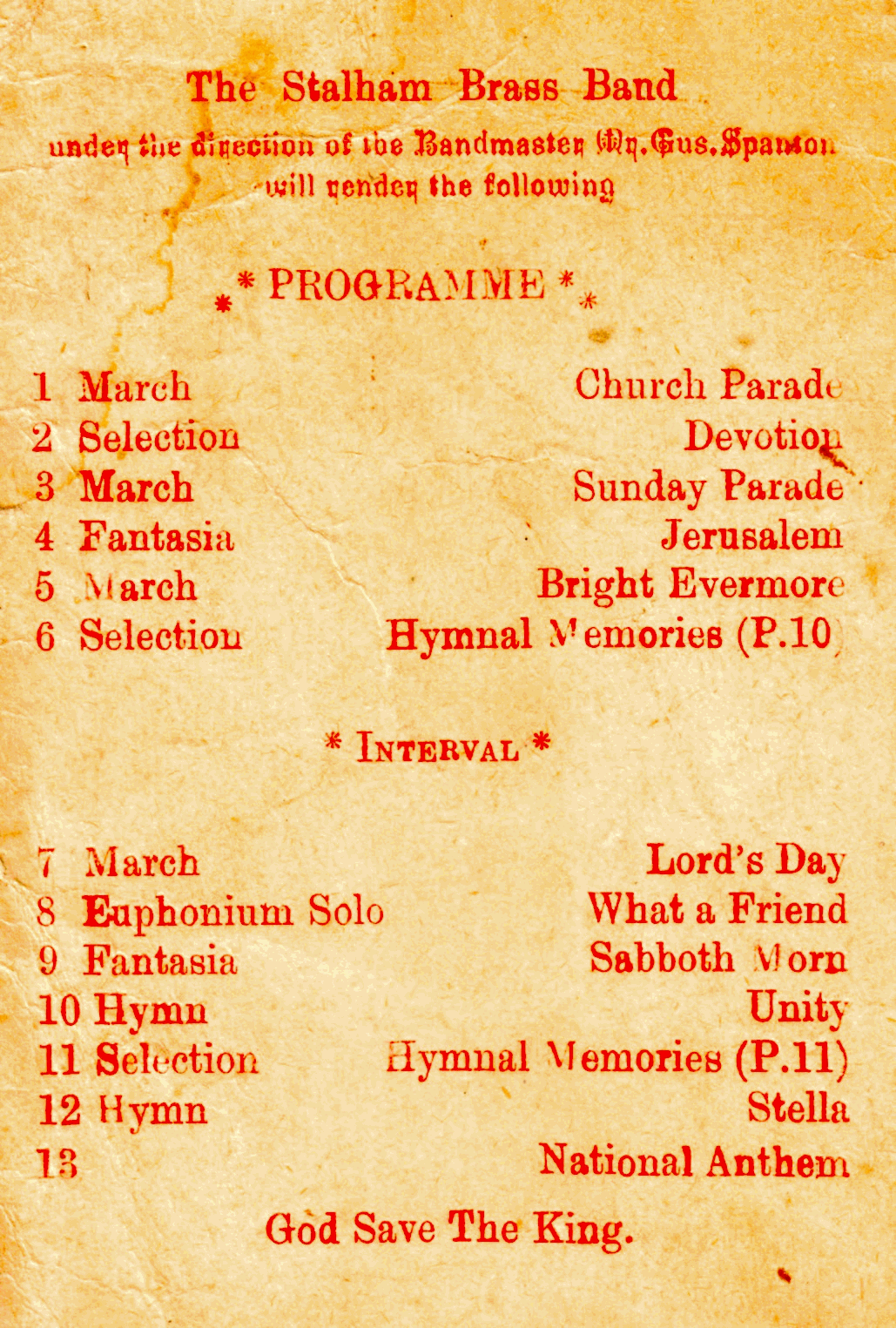
1922 Concert Card
In the early days, transport to an event was by Shanks’ pony, ‘cycle, or horse and cart. Fêtes, carnivals, and parades constantly demanded the presence of the band. It was not unusual for the band to be booked a year in advance. Nowadays the band still plays at functions it has attended for over thirty years, as well as radio, television and film appearances.
In 1885 Stalham was draped in bunting when the band headed a parade celebrating the homecoming from the Sudan campaign of a local member of the Royal Marine Light Infantry, Mr. Herbert Southey Neville White.
On June 13th 1895, the Ludham magazine reported that:
…a gala day organised by the St. Benet’s Lodge and the Sutton Friendly Society was held followed by a Church Parade on Sunday, and a dinner at the "King’s Arms" on Thursday. On all the occasions the Stalham Band was in attendance, with their music adding much to the general effect.
At the turn of the 20th century the band regularly played at special events on Barton Broad. During Barton Regatta the band would play on its ‘own’ island in the Broad. Up until 1926 a firmly established tradition grew up during the annual Wherry Race. The band assembled on a lighter amongst the reeds next to the winning line, and played "See The Conquering Hero Comes" as the winning craft took the gun.
Stalham Band c1923
Back l to r: Frank Spanton, Charlie Riches, Don Catchpole, Lloyd Spanton, W. Bilham, Tom Landsdell, Arthur Roe.
Front: Wilfred Andrews, Bernard Spanton, Don Landsdell, Mr. Keeler, Gus Spanton, Bernard Gibson Mason.
By 1903 the band was going through some difficult times. It was around this time however that the tradition of carol playing or ‘mumping’ around the villages began. It was the custom during the tour of local villages around Stalham for the whole band to be invited into the larger houses to partake of Christmas cheer. Many members of the band’s organisation of friends remember as children going to bed on Christmas Eve only on condition their parents woke them up when the band came round.
Each year the band helps raise thousands of pounds for local charities. Donations during the Christmas period however have traditionally been to keep the band going. Whereas the treasurer used to once call on the landed gentry on Boxing Day for donations, nowadays the band relies on donations given during carol playing.
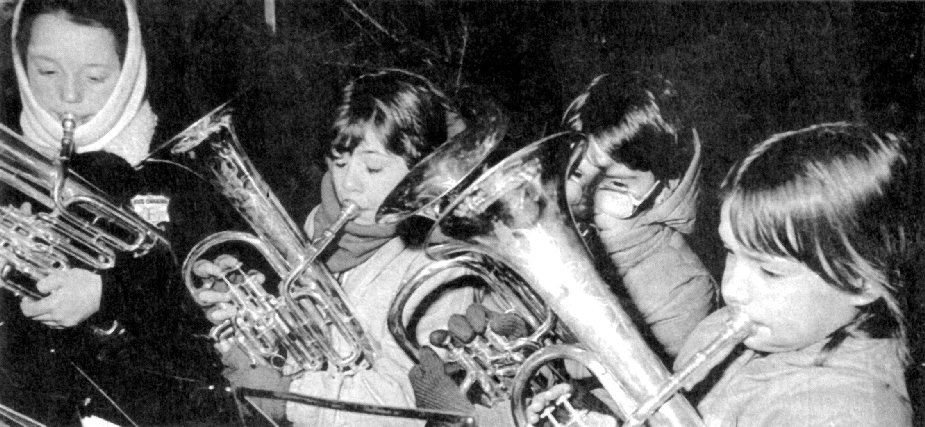
Mumping in Stalham High Street, Christmas 1988
The band at Happisburgh Sports Day 1910
Group includes: Gus Spanton, Ben Gaze, Mr. Collison, Mr. Gaze, Mr Goodwin, Mr. Howard, Percival Bradbury, L. V. Spanton, Mr.Ketteringham, Victor Spanton, Albert Green, Ray Spanton, Paddy Batchelor.
Several bands did not survive the aftermath of the First World War. Martham, Ormesby and North Walsham bands all succumbed. By the 1930’s however those that survived had rebuilt and the movement was quite strong again.
The band leading a parade at Martham in 1933
With the advent of the omnibus - provided by Neaves of Catfield or Starlings of North Walsham - events were taken on further afield, particularly British Legion parades, contests and massed band concerts at Gt.Yarmouth during the summer.
Stalham Brass Band outside the Railway Station for a Sunday concert c1931
Then the Second World War came and made it hard for many to continue. In 1946 following a slow return of members of the Forces the first rehearsal was attended by only four players. This quartet was enough to enable the band to continue to this day. Gerald Thirst was appointed as director of music. In the New Year’s Honours list for 2000, Gerald was awarded the MBE. for 75 years as a player in the band, of which 50 were as director of music. This was also acknowledged as a World Record by the Guinness Book of Records.
Gerald Thirst MBE.
Stalham Brass Band has never had a purpose built building of its own to rehearse in. This is unusual for a ‘Town Band’ with such a long heritage, and something which it has been trying to redress for many years.
After the Second World War and until the late 1970’s the band rehearsed in the old auction hall on the sale ground. Rehearsal rooms at Stalham have included barns; a room in a mill where flour percolated through the ceiling boards every time the drummer beat the big drum; a stable at the Old Vicarage; and a corrugated iron hut next to a garage. None were very warm (with the exception of the bake office at the mill) or comfortable in winter, and it was not unusual for every other player’s position to be replaced by a bucket to catch the rain from the leaking roofs. In cold weather coats, hats and gloves were not removed for rehearsal. Many had ‘cycled or walked miles to get there. There were no toilets and no kitchen in which to make a hot drink, and yet everyone turned up each week without fail.
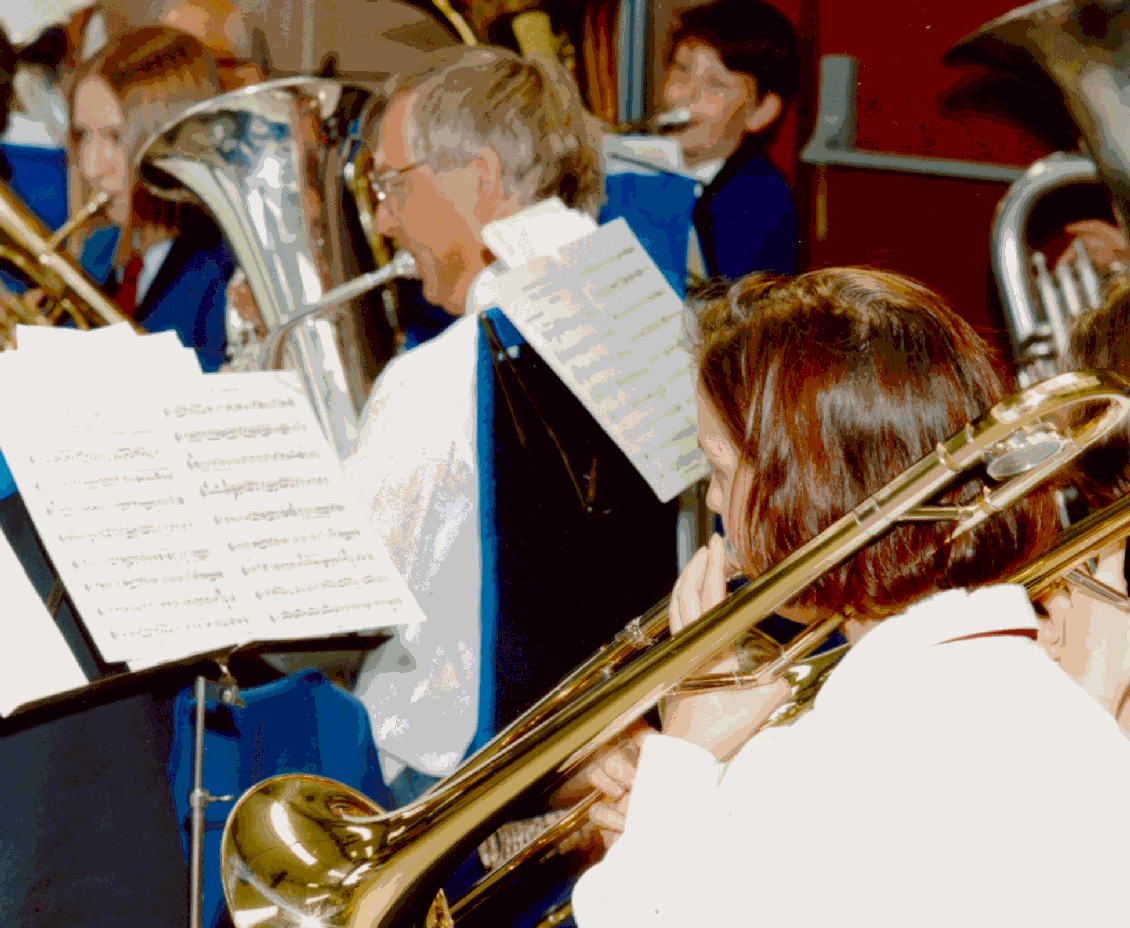
Neatishead Church Fete 1997

Charity fund raising on North Norfolk Railway, June 2006
Of course nowadays employment and training means that players may have to move across the country and to another band. A band’s strength may wax and wane from year to year. Stalham Band is recognised as being an important part of the country’s living heritage, and as such must be handed on from generation to generation in good condition. This not only requires the band to be looking ahead twenty years to ensure its survival, but also requires a special type of person to be a part of it. A Bandsman - in the true sense of the word – has to be a good team member and to work hard for the good of the band. They will always stay the course with their band, however difficult the going may get. Flexible, adaptable, dependable and dedicated to their band and community.
This is why ‘banding’ can never be just a hobby; it is a community commitment with great responsibility not only to the present, but also the future.